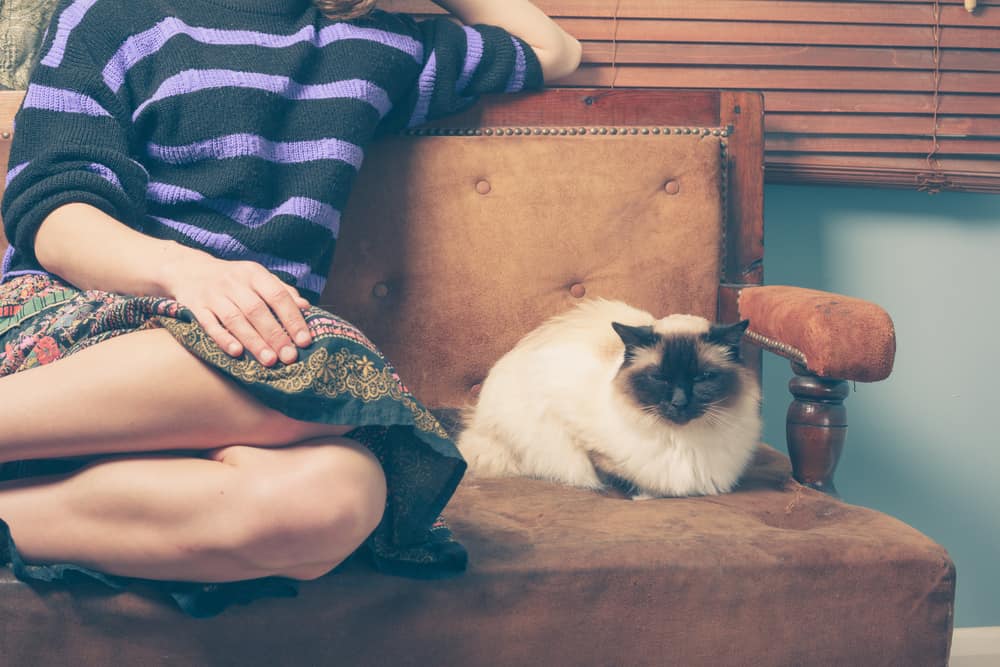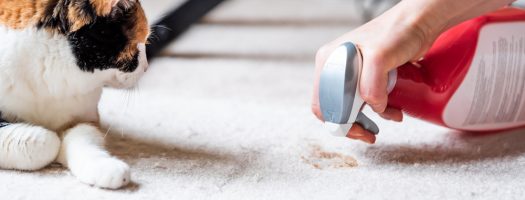Why Do Cats Scratch Things?
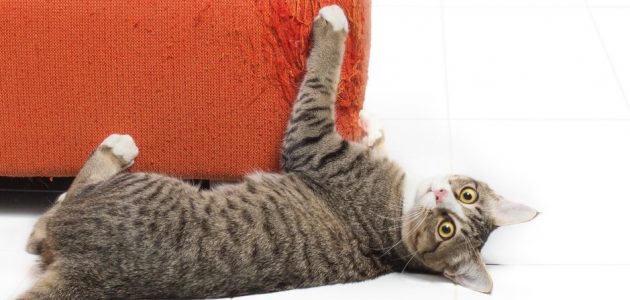
You’re sitting there, binge-watching the latest true crime documentary on Netflix and suddenly you hear it. It makes you alert, heightens your senses and a sudden fear overcomes you.
Now I’m not talking about the smoke alarm or even your neighbor’s constant need to move furniture around (seriously, what are they doing in there?).
No, I mean the haunting sound of your best feline friend scratching away at your newest Ikea purchase like it’s a new toy at Christmas, all the while maintaining eye contact with you as if to say “See this? Mine now, human.” Yes, I’m talking about the forever pet peeve of feline owners worldwide: the scratching.
Now it’s safe to assume that many agree cats are awesome, they’re amazing in so many ways and our love for them can be traced way back to the Egyptian era 4,000 years ago when cats were worshiped as gods.
Whereas dog’s think “They feed me, they love me, they care for me…. They must be a god!” – your cat is probably thinking the opposite “They feed me, they love me, they care for me…. I must be a god!”
Cats are loved all over the world and with many different cultures showing their appreciation in a variety of different ways, such as the famous Kattenstoet for example. We’ve welcomed them into our home, fed them, and given them our utmost love and affection.
So despite all this, why then do they feel the need to scratch and disrupt any material possession you grow affection for? Why is it that even though you have showered them with gifts and treats they still feel the need to knead against your furniture? Let’s dive straight in shall we.
Pulling Theory
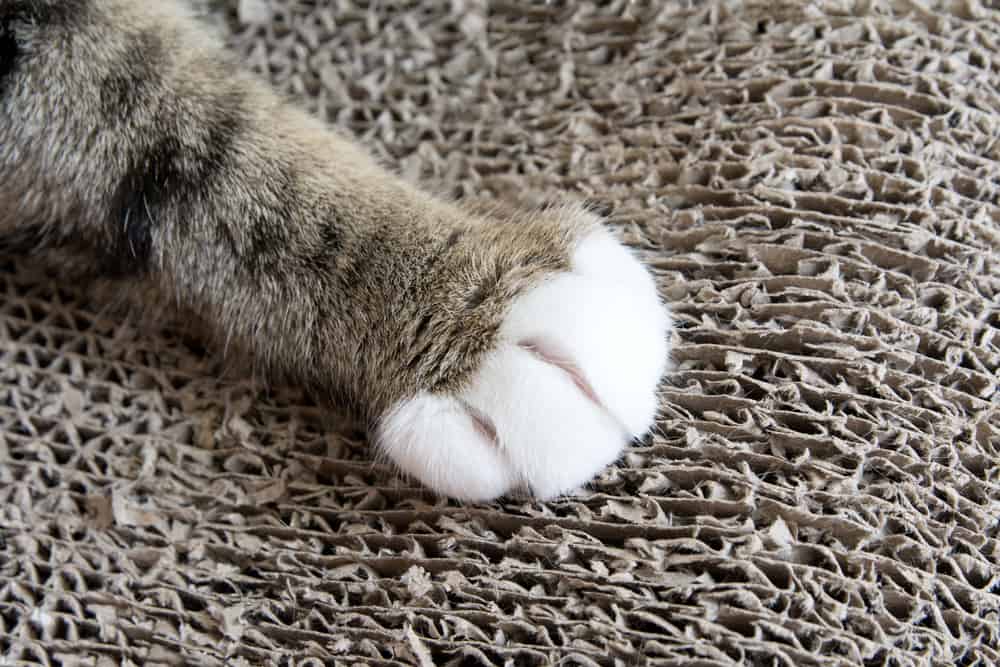
There are a few theories out there as to why cats pull at their claws (sometimes referred to as ‘kneading’ or ‘inappropriate scratching’).
According to Cornell University’s College of Veterinary Medicine, scratching is a normal instinctual behavior in cats. It serves many different purposes and can be linked to several behavioral patterns or ‘signs’ that your cat is trying to convey, such as marking territory, playing, sharpening their claws, stretching after a long nap and they will even do it when they’re excited (like when it’s feeding time for example).
Some cats prefer horizontal scratching while others prefer vertical but in general, any surface with a rugged surface will suffice. They love to scratch on material that they can pull their claws through with some resistance, like cardboard, carpet, upholstery, or even sisal fiber (commonly used for twine).
Other behavioral traits linked to scratching can be fabric chewing or sucking on materials such as wool or even houseplants. This can be more common in younger kittens as a way of demonstrating curiosity and playful tendencies.
Let’s look a little deeper into some of these traits.
Read the Signs
The Humane Society of America states that when your cat scratches something, they’re doing more than just sharpening their claws; they are also leaving their scent as a way of communication between other felines.
Cats have tiny scent glands on the pads of their feet and much like spraying (which involves urinating on objects to leave a ‘scent’) they scratch surfaces to leave a scent to show other felines that this is their territory and ward off potential threats.
This minimizes the potential of contact with other cats and is a behavioral trait found in many different species of Felidae.
Think of it like this, it’s like a notice board for cats but instead of post-it notes, they are leaving messages via a scent which can only be read by other felines (like a network of furry secret agents!).
So next time your cat is clawing up the side of your sofa consider that they may be marking that area for themselves.
Feline Yogi
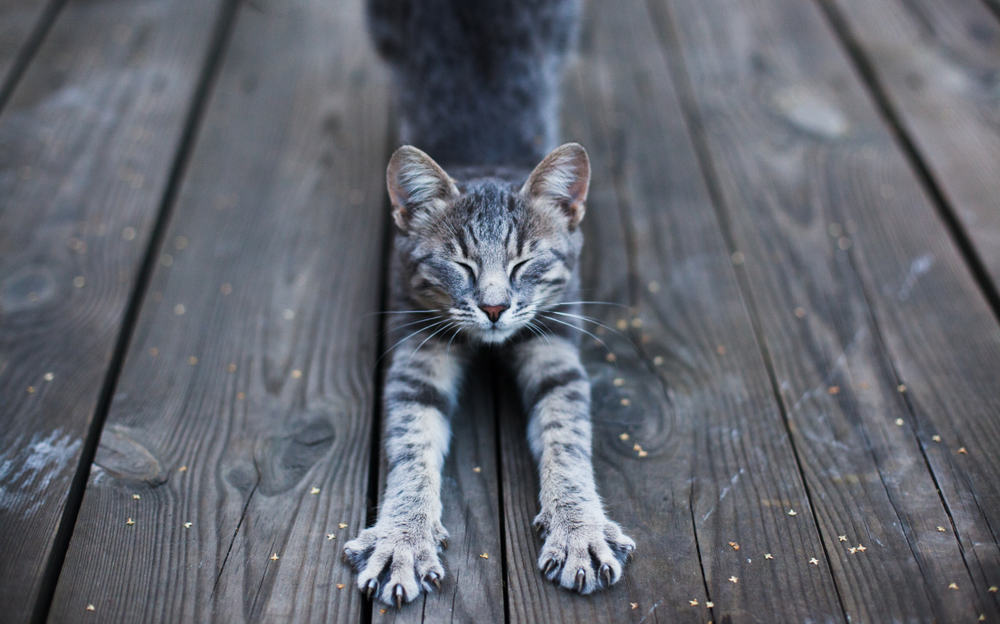
Sometimes cats just need to stretch and one of their favorite ways of achieving this is through scratching and pulling their claws on anything coarse, such as wood, carpet or the drapes.
According to I Hearts Cats, scratching is great for cats to be happy and healthy and it helps them strengthen the muscles they usually use for climbing, hunting, and playing to stop cramping and other muscle-related issues from developing. During this process, they will often use their claws to act as a resistance to help smooth the rough edges of the claws and improve blood circulation.
Just like us humans, cats will often stretch after a long nap or even before exercise and they will even stretch to relieve tension. Doing this will also increase blood flow in their toes.
Excitability in Your Cat
If you’re a pet owner, have you ever felt the unusual sense of excitement in the air when you return home from work or even when it’s feeding time? Cats often show their excitement in many ways including frantically running around the house and rubbing themselves against you and other objects.
One way to demonstrate their excitement is by kneading, whether on your carpet or even on your lap (cat lovers can agree that this is the most acutely painful way of demonstrating affection).
Scratching on a surface will help relieve tension and unload energy. Cats may also demonstrate this activity shortly after using the litter tray. It is very common for a cat to frantically run around the house in a flurry of excitement after going number 2. Many believe this is a way of using their actions to cover the scent from predators or perhaps they are just really relieved.
So if we agree that clawing, kneading, and general scratching is a natural behavior then how can we deal with it? Do we just have to learn to live with it or is there a way we can adjust our lives and find a common ground that will benefit both us and our feline friends?
Can You Stop Them Scratching?
ASPCA (American Society for the Prevention of Cruelty to Animals) suggests that trying to stop your cat from scratching can be harmful to your felines’ natural behavioral patterns and in turn cause them stress. ASPCA states that a healthier approach would be to provide them with cat-attractive surfaces and alternative objects to scratch, such as scratching posts or cardboard scratch-boxes.
A few things to consider when trying to find alternatives. As previously mentioned cats love the feel of coarse materials so a simple method would be to give your cat a post made of materials such as wood, carpet, or upholstery (a good alternative to them scratching your curtains!).
Scratching posts can be found in a wide range of different designs ranging from vertical posts, scratch boxes to even indoor cat trees, and MacBook shaped cat boxes (seriously). These can be found in a majority of pet stores across the US and even online retailers such as Amazon and Esty.
Scratching Posts
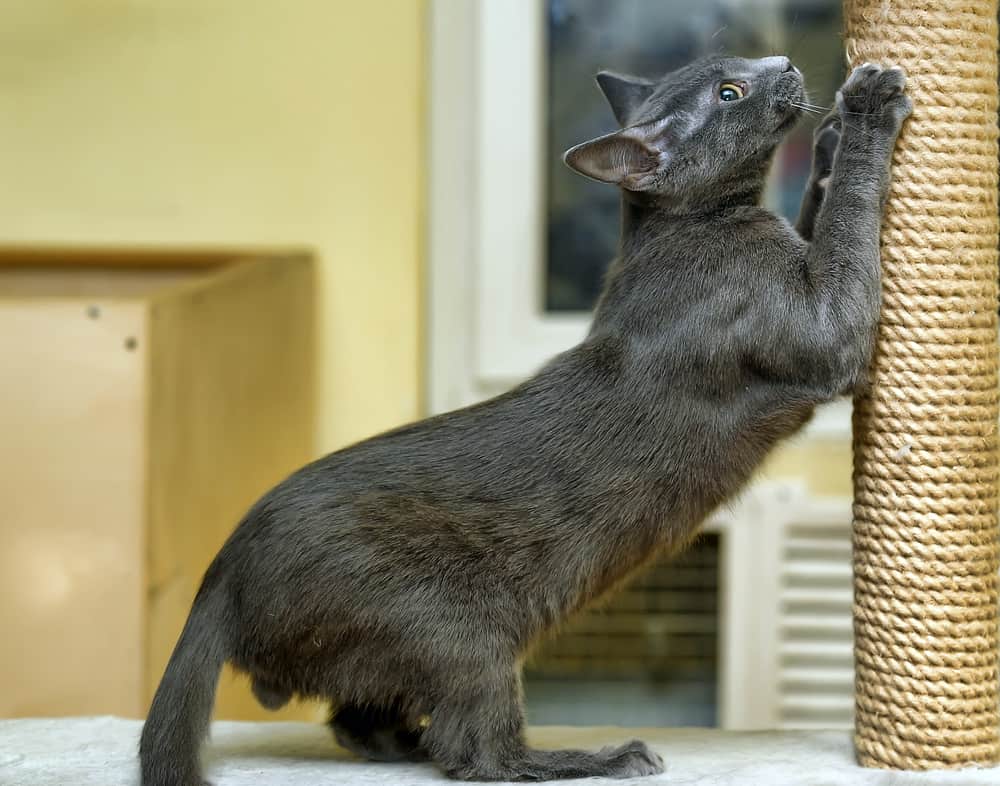
Now certain felines prefer vertical posts while others might be awkward and prefer horizontal surfaces. The best way to be sure is to observe what they do more. For example, do they claw at the sofa or the carpet more?
Once you’ve identified your cats’ preferences it’s time to pick a location, or rather let them pick it for you. Figure out where your cat likes to scratch and place their new scratching post in or near that area. Often, some furniture moving may be required.
Ways to encourage them to use their new scratching posts can range from hanging toys or even using catnip to entice them into using it. The use of familiar objects such as cat toys will make them associate that area with stuff they consider their own.
A couple of things to consider not to do when using scratching posts. Firstly, do not try and encourage your feline friend to use the post by force i.e. pulling their legs over the post and dragging their claws on it.
This could potentially cause damage and make your cat very ypset. Instead, try to encourage them to use it by first sprinkling some catnip on the post and sitting near it. When your cat comes to investigate they will feel comfortable with you being around and the catnip may entice them to mark their territory on the scratching post.
Another method is to reward them after each time they use it. This will encourage them to use the scratch post more as opposed to using your furniture, and the reward will reinforce good behavior.
It’s worth noting that If the scratch post becomes frayed and turns into an eyesore do not fret! Cats love it when their favorite scratching surface becomes torn and it might encourage them to use it even more.
Homemade Remedies to Excessive Cat Scratching
Some homemade remedies can be used as alternatives to purchasing cat posts. For example, placing double-sided sticky tape to items that your cat is attracted to is one way to deter them away from clawing at your furniture.
The underside of carpeted placemats can also be used as an alternative, as it provides the perfect surface for cats to claw their way through. Just ask your local carpet store for some carpet samples or offcuts!
There are also some creative and helpful tips to help prevent scratching including placing a tower of plastic cups near their favorite piece of scratching furniture and when they accidentally knock it over, they’ll become startled.
Even placing a small balloon over the area ready to ‘pop’ when they place their claws upon it can work. Both of these make them wary of that particular area and will in turn stop them from scratching there.
Another way to deter your cat from scratching a particular piece of furniture is to clap your hands near them as a way of signaling bad behavior. It should be noted that according to PETA (People for the Ethical Treatment of Animals), this should be used as a last resort; as it can lead to your cat associating fear and startling events with you.
You should also never use physical force towards your cat. Cats do not usually respond well to any sort of punishment. This is because they rarely associate the action with the crime and could potentially cause them to distrust you. We want our furry friends to love us not fear us!
Boredom

Over excessive scratching can also be a sign of boredom for your furry friend. According to DAWS (Danbury Animal Welfare Society) other signs of boredom to look out for including overgrooming and repetitive behaviors (such as constant chewing, biting, licking), overeating, a general sense of moping about the house, and a complete lack of curiosity in their environment.
If any of these signs can be found then there are multiple ways of tackling it. These include putting more toys around the house, higher perches for them to climb onto, and even more window space for them to observe the outside from. PETA even have some great ideas for toys to entertain your feline pal.
If any of these signs continue to show then do not hesitate to contact your local veterinarian for advice.
Pheromone Spray
There are many odor based sprays and diffusers on the market that use feline facial pheromones to reduce erratic behavior in cats. Companies, such as Feliway, have a variety of products available that according to them nurtures your relationship with your cat, by creating a loving environment at home.
The science behind this is fairly simple as it mimics natural pheromones to help reduce stress and create a calm environment for your pets. This one-step fix should work on most cats but don’t be alarmed if they don’t as not all cats will respond to it.
These come in a wide range of products including diffusers, sprays, wipes, and collars. These companies suggest that by using or spraying their product on or around your cats’ scratching post will not only encourage them to use it more but will also help prevent other erratic behaviors such as overgrooming, spraying and even fighting with other cats.
There are many pheromone sprays to choose from such as Comfort Zone Spray & Scratch Control Spray or Pet MasterMind’s Lion Tamer Cat, both tailored towards preventing your cat from scratching on unwanted surfaces.
These particular remedies can also be used to welcome a new kitty into your home or as a helpful way of ‘keeping the peace’ when introducing new pets.
Cat Manicure
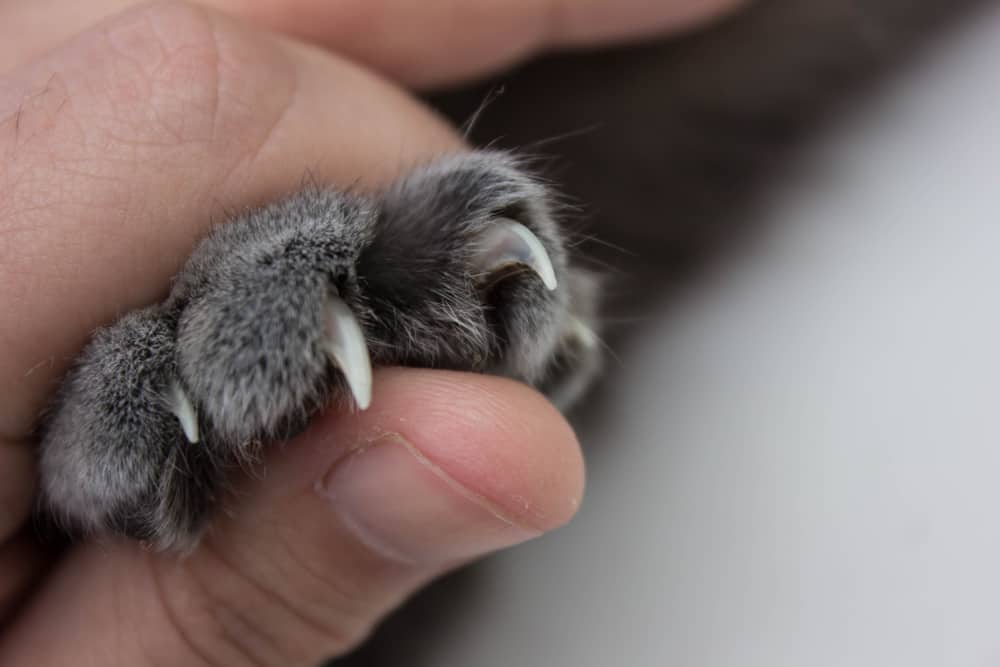
As we’ve seen, cats can sometimes scratch to help maintain their nails and one way to reduce this action is to cut their nails for them.
Cutting back or trimming your cats’ claws can often reduce the amount of clawing they do to furniture around the house. A few tips when trimming your cats’ claws would be to first purchase a reliable set of pet nail clippers.
These can be easily purchased either from your local pet store or from an online retailer. Then there are some steps that you may want to follow to ensure an easy process for both you and your feline friend.
Firstly, you will need to set the mood to create a safe atmosphere for your cat. Introducing the clippers to your cat slowly and reassuring them that the clippers are not a cause for concern will make the process much easier for the future.
So make sure the environment is set by not having any other pets around and making sure that they are relaxed (perhaps after a big meal). Before getting settled, take out a piece of dry spaghetti, this will be used to introduce the clippers to them.
Once you have become comfortable with them, gently massage their paw and squeeze one of the toe pads. When the nail extends simply cut the spaghetti with the clippers. Now release the toe pad and give her a treat. This will show the cat that the clippers are harmless and they have nothing to fear! It will also teach them to associate the clippers with a tasty reward.
Once you have reinforced this with positivity your feline friend should no longer be afraid of the clippers and you can begin to trim. One very important thing to note when clipping their nails be sure not to trim too deep and never cut the ’quick’ of the nail. This is the pink part of the nail that contains nerve endings and if cut, can cause your cat some discomfort and pain. Remember to reward them with a treat for being a good kitty.
False Nails
Some companies have been experimenting with a simple solution to cats pulling their claws by introducing nail caps that act as a barrier between them and your furniture.
They work just like false nails and if applied correctly, sit on the end of each claw to soften and smooth the impact on surfaces without causing any discomfort to our feline friend.
Many pet owners agree that this is an easy and humane way of dealing with a stretching issue without resorting to declawing.
Before applying these to your cat is highly recommended to ask your vet to show you how to apply them safely.
Declawing
There are some people out there that suggest that declawing your cat is a great way to stop unnecessary scratching. Although it is illegal in many countries, in some counties within the United States declawing is a legal procedure that should always be conducted by a veterinary professional.
Put simply, declawing is the surgical removal of the last bone of each digit in the front paws. Generally, declawing is only done on the front paws, and removing the rear claws is rarely ever done.
However, many experts suggest that this can be quite stressful and potentially harmful to the cat as it can cause them significant pain, even after the surgery has long passed. PETA even states that declawing a cat is the equivalent to cutting a human finger off at the first knuckle (which can’t be pleasant).
PETA even suggests that without their claws, cats can often find difficulties with walking and can even become aggressive. It is worth noting that if you do go ahead with this procedure then it is advisable to keep your cat indoors at all times. This is because without claws your cat may find it difficult to climb and defend themselves against possible enemies or other dangers out in the wild.
One very important note, if you are considering this treatment, is to look up your local county laws; as laws may differ depending on where you live.
So some of these methods may appeal to you and it is worth experimenting with them to figure out the best way to deal with scratching.
Finding Peace
Now that we have solved the mystery as to why our furry friend loves to destroy our beloved sofa, you can sit back and relax into your favorite Netflix show once again. Safe in the understanding that our fluffy amigo is happy and content with their new situation.
We’ve identified that clawing is a perfectly natural behavior in cats and there are many methods available to try and find common ground with you and your pet. Clawing is a completely natural instinct for our feline friends and by finding a suitable way of dealing with it we can once again begin to create peace and help us find harmony in our homes.
Whether it be purchasing and using a scratch post, clipping their nails, or finding homemade remedies, finding out which solution works best for you and your cat can be a very rewarding experience.
It is worth noting that if any of these remedies do not work or if you feel uncomfortable pursuing any of these then do not hesitate to contact your local veterinarian for professional advice. Using any of these methods will not only save your beloved furniture from being destroyed but will also keep your feline friend happy and healthy.
